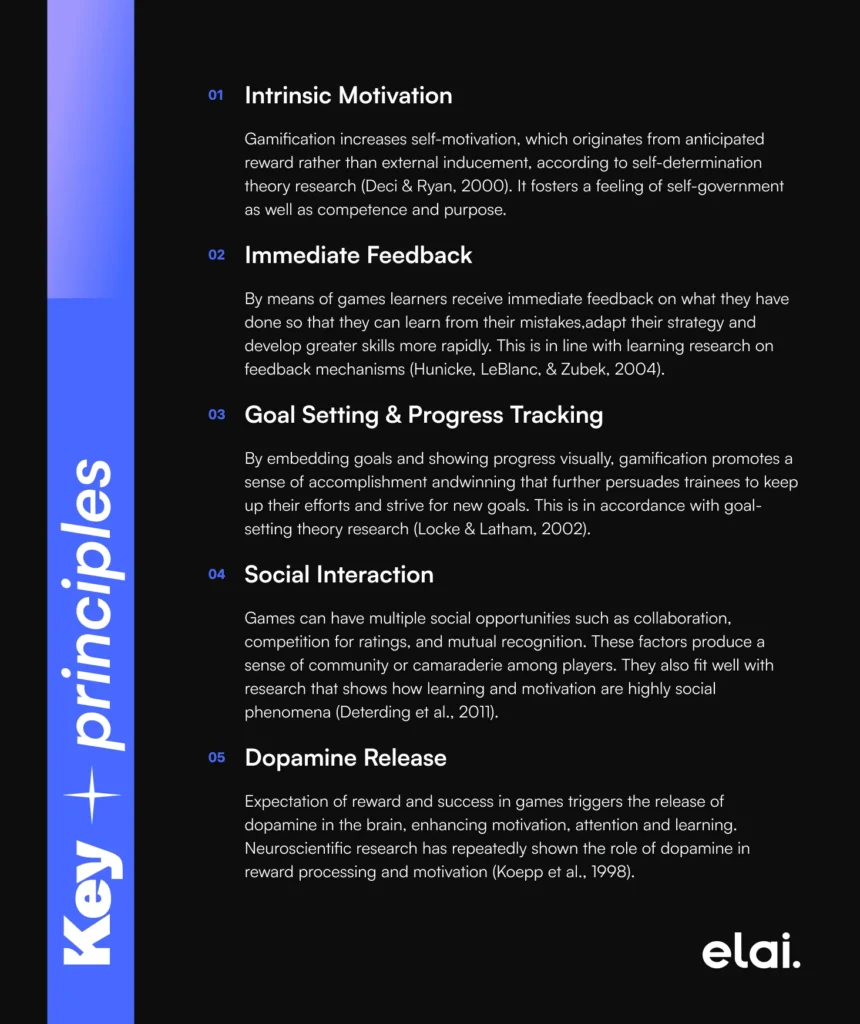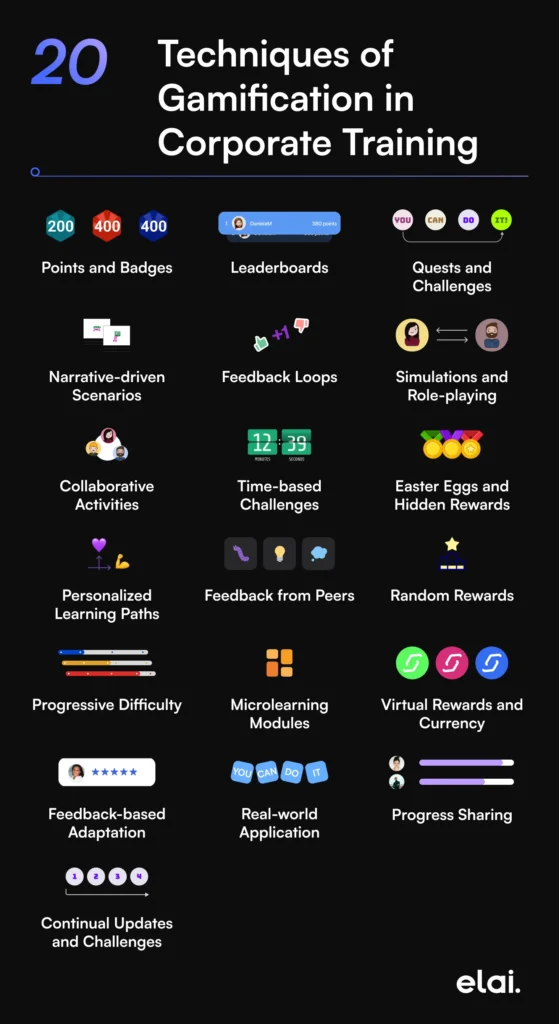20 Innovative Techniques for Gamified Learning
Inna Horvath2025-05-16T20:15:05+03:00One tactic that keeps gaining in popularity is the integration of game elements and mechanics into other settings, such as training programs and workplace tasks. This process, which is known as gamification, is today widespread. Along with 20 other techniques outlined in this article for implementing gamification in corporate training, one thing should be made clear: There are scientific reasons why it works.
The Science Behind Gamification
Gamified learning incorporates insights from psychology, neuroscience, and behavioral economics to stimulate and engage learners. Several key principles illustrate why gamification is effective:

• Intrinsic Motivation: Gamification increases self-motivation, which originates from anticipated reward rather than external inducement, according to self-determination theory research (Deci & Ryan, 2000). It fosters a feeling of self-government as well as competence and purpose.
• Immediate Feedback: By means of games learners receive immediate feedback on what they have done so that they can learn from their mistakes, adapt their strategy and develop greater skills more rapidly. This is in line with learning research on feedback mechanisms (Hunicke, LeBlanc, & Zubek, 2004).
• Goal Setting & Progress Tracking: By embedding goals and showing progress visually, gamification promotes a sense of accomplishment and winning that further persuades trainees to keep up their efforts and strive for new goals. This is in accordance with goal-setting theory research (Locke & Latham, 2002).
• Social Interaction: Games can have multiple social opportunities such as collaboration, competition for ratings, and mutual recognition. These factors produce a sense of community or camaraderie among players. They also fit well with research that shows how learning and motivation are highly social phenomena (Deterding et al., 2011).
• Dopamine Release: Expectation of reward and success in games triggers the release of dopamine in the brain, enhancing motivation, attention and learning. Neuroscientific research has repeatedly shown the role of dopamine in reward processing and motivation (Koepp et al., 1998).
Among the benefits of gamification is the fact that gamification enhances learning and engagement by applying game-design elements in non-game contexts, making tasks more enjoyable and motivating. One of the best gamification examples is Duolingo, which uses gamification by awarding points for completing language lessons, encouraging users to maintain streaks and compete with friends.
20 Techniques of Gamification in Corporate Training

Points and Badges: Award points or badges to learners for completing tasks, achieving milestones, or demonstrating mastery of skills.
Leaderboards: Create leaderboards to rank learners based on their performance, fostering healthy competition and motivating participants to excel.
Levels and Progress Bars: Divide training modules into levels or stages, allowing learners to track their progress and visualize their advancement.
Quests and Challenges: Present training objectives as quests or challenges, complete with missions, objectives, and rewards for successful completion.
Narrative-driven Scenarios: Embed training content within a narrative-driven storyline, immersing learners in an engaging and memorable learning experience.
Feedback Loops: Provide immediate feedback on learners’ actions and decisions, guiding them toward optimal performance and continuous improvement.
Simulations and Role-playing: Create realistic simulations or role-playing scenarios that mirror workplace challenges, allowing learners to apply knowledge in a risk-free environment.
Collaborative Activities: Encourage collaboration and teamwork through group activities, problem-solving exercises, and cooperative challenges.
Time-based Challenges: Introduce time-based challenges or deadlines to increase urgency and motivation, simulating real-world pressures and deadlines.
Easter Eggs and Hidden Rewards: Include hidden rewards or “Easter eggs” within training content to incentivize exploration and engagement.
Personalized Learning Paths: Offer personalized learning paths tailored to individual learner preferences, goals, and skill levels.
Feedback from Peers: Enable peer feedback and review mechanisms, allowing learners to receive constructive criticism and recognition from their peers.
Random Rewards: Incorporate random rewards or surprises to keep learners engaged and motivated, creating a sense of anticipation and excitement.
Progressive Difficulty: Gradually increase the difficulty level of training challenges as learners advance, ensuring a challenging yet achievable learning experience.
Microlearning Modules: Break training content into bite-sized modules or microlearning units, making it easier for learners to digest and retain information.
Virtual Rewards and Currency: Introduce virtual rewards, currency, or tokens that learners can accumulate and exchange for real or virtual incentives.
Feedback-based Adaptation: Adapt training content based on learners’ performance and feedback, ensuring personalized and adaptive learning experiences.
Real-world Application: Provide opportunities for learners to apply newly acquired knowledge and skills to real-world scenarios, reinforcing learning outcomes.
Progress Sharing: Allow learners to share their progress and achievements with colleagues or peers, fostering a culture of transparency and recognition.
Continual Updates and Challenges: Regularly update training content and introduce new challenges or content updates to keep learners engaged and motivated over time.
Gamification vs game based learning
Gamification and game-based learning are both ways to use game features in business and education, but they are very different in how they are used and what they are trying to achieve. Gamification is the use of game design features like points, badges, and leaderboards in non-game settings to get people more interested, motivated, and involved. It’s about using the motivational techniques that games use in other areas, like marketing, education, or employee performance, to get people to engage more deeply with the content. Or activities by playing on their natural needs to compete, achieve, and be praised.
On the other hand, game-based learning is when games are used directly to teach, and the learning is built around playing the games. These games were chosen or made to help students learn a certain subject, get better at a certain skill, or understand a certain idea through the way they work and the stories they tell. This method is more immersive than gamification because students aren’t just inspired by adding game elements to the learning setting; they are also actively learning through the gameplay. This makes difficult ideas easier to understand and more interesting by letting students deal with them directly. Adding game-like features to any action is called “gamification.” Game-based learning, on the other hand, uses games to teach important lessons.
Transforming Training with Gamification
The integration of gamification in training is nothing less than a game-changer in how companies engage, motivate, and empower employees. By introducing game elements and mechanisms into training, corporations can create learning experiences that are immersive, interactive, and more effective in driving motivation, engagement, and acquisition of skills.
In embracing gamification, companies will usher in a new era of corporate training – an era where learning is not only the acquisition of knowledge and skills, but an exciting adventure in exploration, growth, and achievement. With these 20 techniques, companies can maximize the potential of gamification and become trailblazers in the “world of play” that will define the future of corporate training.
In sum, gamification in learning provides corporations a powerful way to combat training and development “fatigue” to create experiences that inspire – and are inspired by – their employees, fostering a culture of learning that is constant and enthusiastic and produces real-world results. As the corporate learning landscape continues its rapid evolution, gamification is a beacon of innovation and possibility, setting a course for the future of learning in the digital era.
FAQ
What is gamification in learning?
Gamification in learning is the integration of game elements, such as points, badges, and leaderboards, into educational activities to increase engagement and motivation.
How does gamification enhance learning?
Gamification enhances learning by leveraging the motivational effects of game elements to make educational activities more engaging and rewarding, thereby improving participation and retention.
What is the difference between game based learning and gamification?
The difference between game-based learning and gamification is that game-based learning involves using actual games to facilitate learning, whereas gamification applies game-like elements to non-game contexts to motivate and engage.
What is game based learning?
Game-based learning is an educational approach that uses video games or game mechanics to teach specific skills, concepts, or knowledge, engaging students directly through gameplay.
How to gamify learning?
To gamify learning, one can introduce elements like scoring systems, challenges, levels, and instant feedback into educational activities to create a game-like learning environment.
How to gamify training?
To gamify training, incorporate game mechanics such as progress tracking, rewards for achievements, competitive elements, and interactive scenarios that mirror real-life challenges to enhance engagement and learning outcomes.











